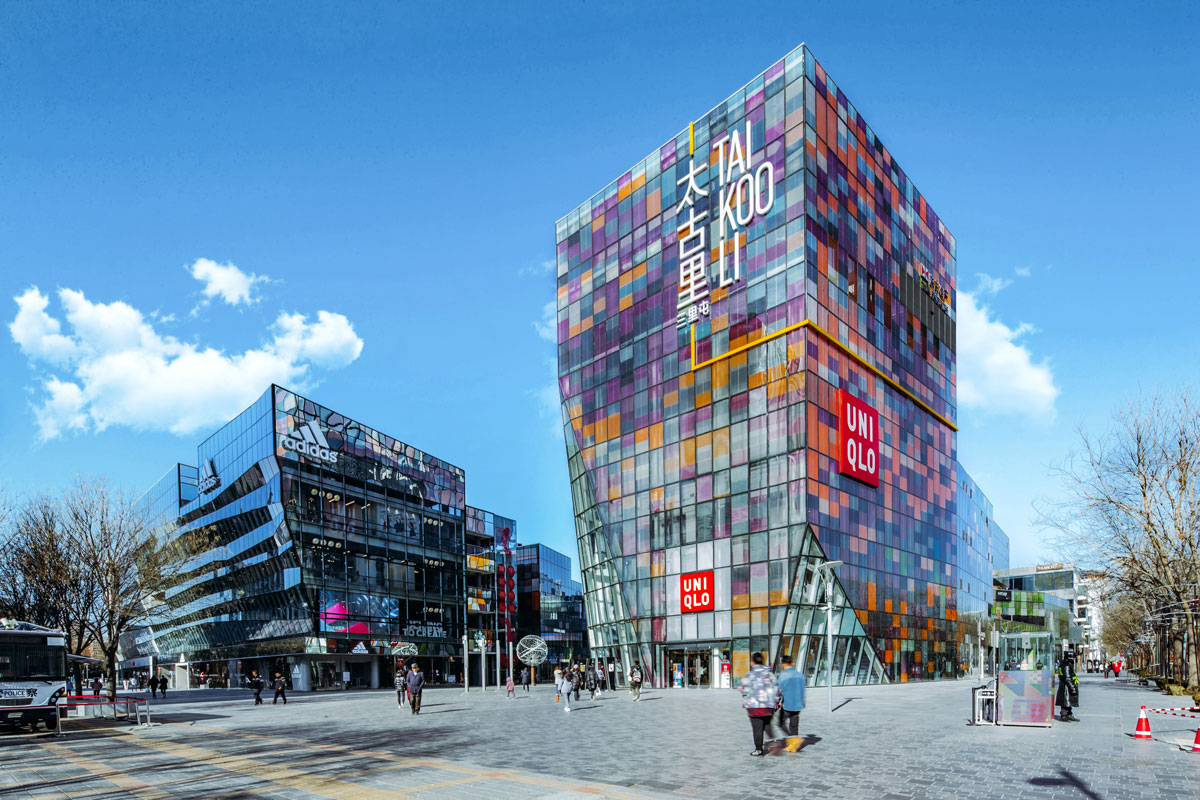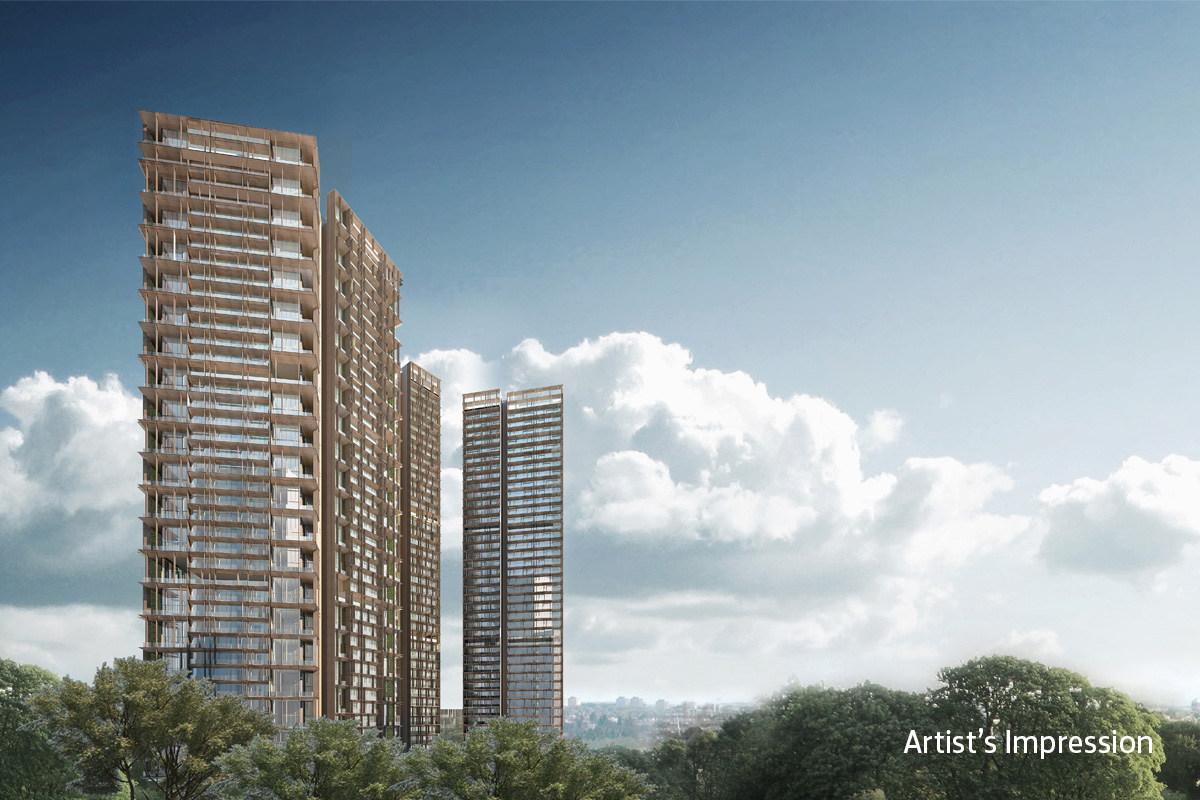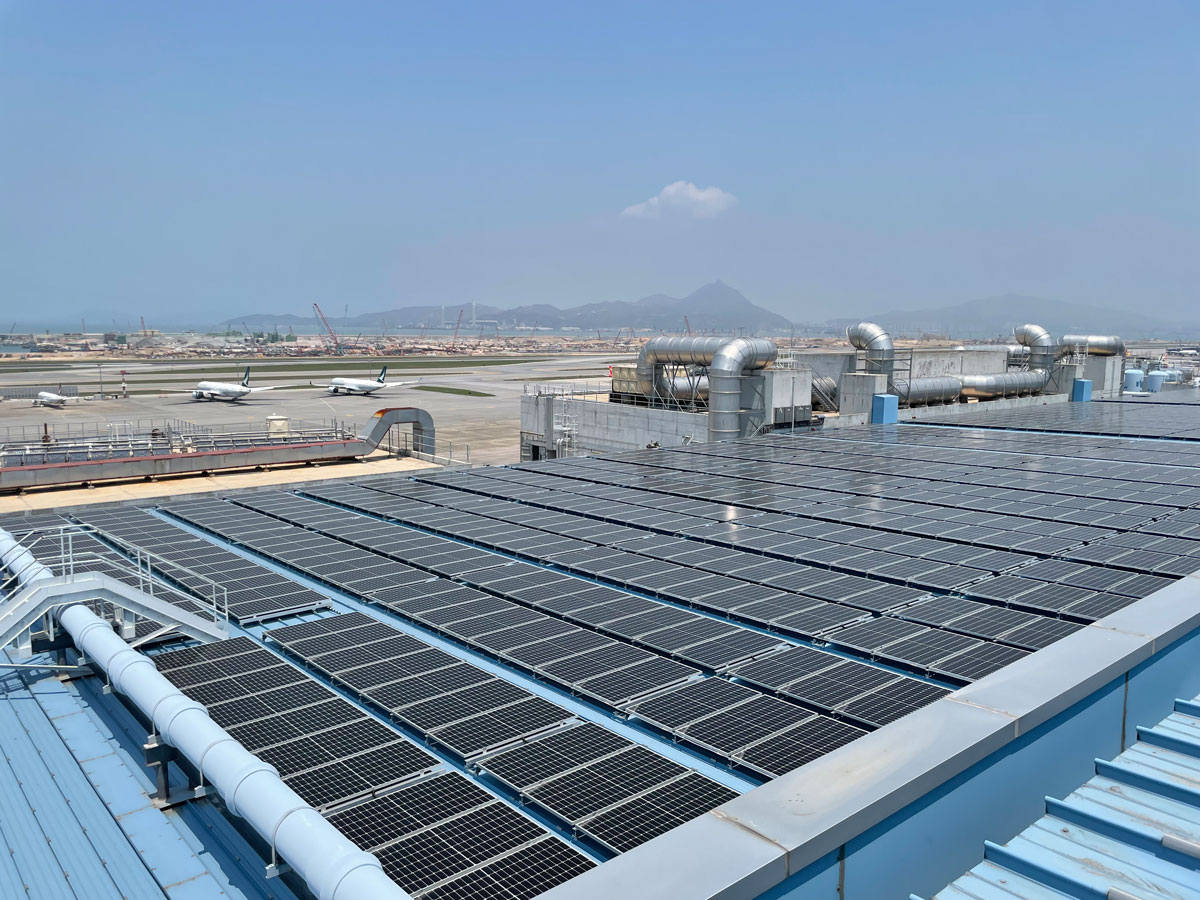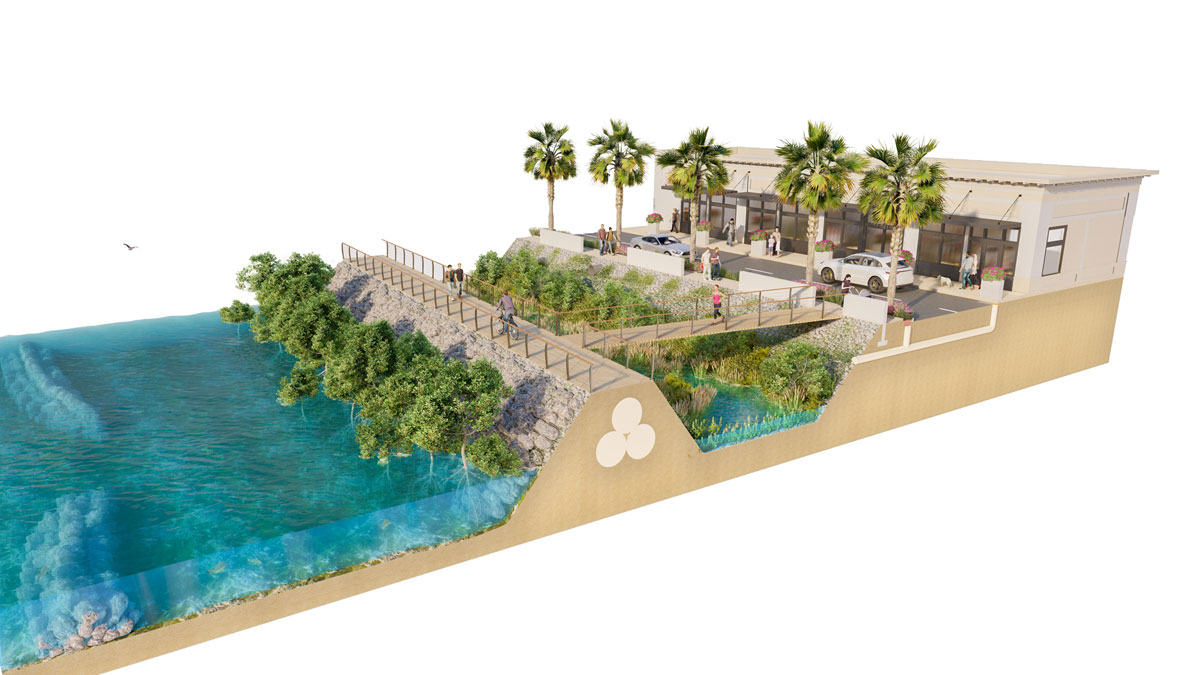Decarbonise our business
and build climate resilience

Climate change is one of the biggest challenges facing the world today. The science is clear: unless global emissions reach ‘net zero’ by 2050, the devastating heatwaves, storms and floods we have seen in recent months will only get worse. Achieving net zero requires unprecedented levels of decarbonisation across all sectors, starting immediately. Pledges made by global governments and financial institutions at the 2021 UN climate summit (COP26) send a clear message to business that the transition to a low-carbon economy is accelerating, and that legislation, access to capital and new markets will favour those taking action to address climate change. Everyone must play their part to limit global temperature rise to 1.5°C, in line with the Paris Agreement.
Decarbonising our operations is a strategic imperative. But global warming is already shifting weather patterns, threatening water and food supply and affecting human health. To remain resilient, our businesses and the communities in which we operate must be prepared to withstand or respond to these changes.
Our Climate Change Policy outlines what we will do to reduce our emissions and adapt to climate change. It was updated in 2021 to reflect our net zero goal.
Our ambition is to achieve net zero emissions by 2050. This will not be easy. We operate and invest in the carbon intensive aviation and shipping sectors, which are difficult to decarbonise without breakthroughs in alternative fuel technology.
Our interim target is to halve our scope 1 and 2 emissions by 2030, compared with a 2018 baseline. Each of our businesses has individual targets aligned with science-based targets, nationally determined contributions, or international industry commitments. Swire Properties and Swire Coca-Cola have set science-based targets aligned with the 1.5°C pathway and approved by Science Based Targets Initiative (SBTi). Both companies have signed up to Business Ambition for 1.5°C.
To reduce emissions, we are:
Improving energy efficiency
Using more renewable energy
Choosing low-carbon and energy efficient products and materials
Encouraging our suppliers and customers to decarbonise
Carbon removal and verified carbon offsets will form part of our strategy, particularly in aviation and shipping where low-carbon solutions are not yet available at scale. But our priority is to reduce our absolute GHG emissions as much as we can first.
The Group generated 683 thousand tonnes of GHG emissions in 2021, a 12% decrease from 2020.
The Beverages and Property divisions accounted for almost 80% of the Group’s emissions in 2021. Despite using more energy overall, Swire Coca-Cola and Swire Properties reduced their absolute GHG emissions by 4% and 8% respectively. Increased procurement of renewable electricity in the Chinese Mainland contributed to this improvement.
The emissions of the Aviation and Marine Services divisions decreased by 10% and 52% respectively compared with 2020. This was in part due to COVID-19 related reductions in business activity, reduced fleet size, as well as the divestment of HUD in September 2021 and the 2020 listing of Cadeler A/S (formerly Swire Blue Ocean), which is no longer included in our 2021 performance data. For full details of the scope of our data, please see our Reporting methodology.
Emissions from the Trading & Industrial Division increased by 4%. Hotter weather led to increased demand for cooling at Taikoo Motors and Taikoo Sugar opened its new Kwai Chung plant in Hong Kong in 2021.
By 2030, we aim to reduce our scope 1 and 2 emissions by 50%, compared with 2018 levels. In 2021, we achieved a 18% reduction compared to our baseline. We have adjusted the baseline and performance figures shown to reflect the divestment of HUD group and other businesses between 2018 and 2021.
As the cost of electricity rises, making our buildings and operations more energy efficient is a priority.
Designing efficient buildings
Our Sustainable Building Design Policy requires new and substantially renovated buildings to obtain the highest or, as a minimum, the second highest international or local building environmental certification.
At the end of 2021, 96% of Swire Properties’ existing buildings have been certified as green buildings under HK BEAM, BEAM Plus, LEED, WELL, China Three Star or Green Mark independent rating systems. 100% of its projects under development have achieved the highest ratings. Swire Coca-Cola has five LEED certified bottling plants in the Chinese Mainland and the US.
Energy saving measures
Across the Group, we continued to upgrade our lighting, cooling, boiler and refrigeration systems to more energy efficient models.
In 2021, Swire Properties optimised heating, ventilating and air conditioning systems, installed high-efficiency chillers and variable speed drives for water pumps, modernised lifts and escalators, and replaced lighting with LEDs. Approximately 86% of its assets (by gross floor area) in Hong Kong and the Chinese Mainland are certified to the ISO 14001 and ISO 50001 standards for environmental and energy management.
Swire Properties is rolling out a cloud-based smart energy management platform across all its properties in Hong Kong and the Chinese Mainland. Developed with Schneider Electric, the platform uses the Internet of Things, big data analysis, artificial intelligence and cloud computing to generate energy saving insights and optimise energy consumption. At the end of 2021, the platform had been implemented at six of its commercial properties. The system at Cityplaza generated over 200,000kWh in energy savings between June and September 2021.

Swire Properties – Trialling cutting edge technology solutions
With support from the Swire Pacific Sustainable Development Fund, Swire Properties is developing trials of two cutting edge technology solutions that could achieve significant energy savings. They include:
- Designing and testing integrated direct current (DC) microgrid infrastructure, which reduces electricity conversion loss between systems and supports PV panels and low-carbon fuel cells; and
- Piloting a sub-micron heat transfer fluid technology, which uses aluminium oxide nanoparticles to increase chiller efficiency.
Should these trials prove successful, the technology will be adopted at scale.
Swire Coca-Cola partnered with Tsinghua University to install a more energy effective refrigeration system at its Jinqiao Shanghai plant that is expected to save 2.6 million kWh of electricity per year. Combined with other upgrades to cooling, compressors refrigeration and wastewater treatment systems at its Hefei, Jiangsu and Huizhou plants, the initiatives are expected to generate more than HK$2 million in annual cost savings. A separate study of three plants in the Chinese Mainland identified opportunities to reduce electricity and steam demand by an average of 16% and 20% respectively.
Shifting our energy mix to renewable sources is a crucial part of our decarbonisation strategy. We encourage our businesses to explore opportunities to generate and purchase more renewable electricity. Swire Properties and Swire Coca-Cola have set renewable energy targets.
Proportion of electricity consumed from renewable sources
(million kWh)
Proportion of electricity consumed from renewable sources
(million kWh)
| 2020 | 2021 | |
| Total electricity used by the Group | 893 | 880 |
| Total RE generated on our sites | 20.7 | 20.5 |
| Total RE procured | 11.5 | 31.4 |
| % electricity used by the Group that was from renewable sources | 3.6% | 5.9% |
More than 20 million kWh of electricity was generated from renewable sources at Swire Properties, Swire Coca-Cola and HAECO Xiamen in 2021. Swire Coca-Cola completed the installation of a new solar PV system at its plant in Wenzhou, Chinese Mainland, which is expected to generate 2 million kWh of electricity per year. In Colorado Springs, US, it installed a PV system with 900 kW solar capacity, which covers more than 100% of the energy needed to power the building. EIGHT STAR STREET is Swire Properties’ first residential project to adopt solar panels, which will produce 2,110kWh of electricity annually, and in early 2022, it completed installation of a 65kW PV system at its Dorset House commercial building in Hong Kong.
Our major subsidiaries are taking advantage of changing regulation in the Chinese Mainland to purchase more renewable electricity. Swire Properties now procures 100% renewable electricity for Taikoo Hui, Sino-Ocean Taikoo Li Chengdu and The Temple House, increasing its mix of renewable electricity in the Chinese Mainland to about 47%. Swire Coca-Cola’s plants in Yunnan, Hubei and Shanghai Jinqiao are powered by 100% renewable electricity. It is developing a comprehensive roadmap to increase renewable energy use across its operations in the Chinese Mainland.
Since 2020, Swire Properties has included low-carbon procurement specifications – developed in accordance with international standards such as ISO 14067 – for construction materials such as concrete with pulverised fuel ash or ground granulated blast furnace slag, rebar and structural steel with recycled content. It is the first real estate developer in Hong Kong to contractually require low-carbon building materials for new projects and is exploring extending this practice to its developments in the Chinese Mainland.
All new Swire Coca-Cola Hong Kong trucks can use B7 biodiesel and comply with Euro VI emission standards. In 2021, Swire Coca-Cola replaced existing biomass boilers at its Huizhou and Guangxi plants with ones that run on natural gas, which produces fewer emissions.
The majority of our GHG emissions occur outside our direct operations. We do not control these assets and activities, but through our decisions and relationships we can work to reduce material scope 3 emissions. Swire Pacific has a significant interest in Cathay Pacific, and accounts for a proportion of its GHG emissions under our scope 3. This proportion is equivalent to the Group’s ordinary shareholding interest in the company.
| Material value chain emissions | Swire Pacific’s interest | 100% Total emissions (thousand tonnes CO2e) | Attributed to Swire Pacific (thousand tonnes CO2e) | % change | ||
|---|---|---|---|---|---|---|
| At 31 Dec 2021 | 2021 | 2020 | 2021 | 2020 | ||
| Cathay Pacific Group | 45% | 6,060 | 7,589 | 2,727 | 3,415 | -20% |
Cathay Pacific has committed to achieving net zero carbon emissions by 2050, and for sustainable aviation fuel (SAF) to constitute 10% of its total fuel consumption by 2030. Its carbon reduction strategy includes modernising its fleet to improve fuel efficiency, improving operational efficiency, and providing Gold Standard accredited offsets through its Fly Greener programme. See Cathay Pacific’s Sustainable Development Report for details.
Representatives from Cathay Pacific are active members of our SwireTHRIVE working groups and committees, and benefit from the collective experience, expertise and best practice sharing between our companies. We also support carbon and waste reduction projects at Cathay Pacific through our sustainable development fund.
We plan to conduct a mapping exercise to identify other material sources of emissions in our investments and in the value chains of our businesses and will disclose more in future reports.
Tenant electricity consumption accounts for 50 to 60% of Swire Properties’ total building energy consumption. Swire Properties helps tenants to reduce their electricity use by offering free energy audits. Since 2008, free energy audits have covered 5.8 million square metres of commercial space, identifying potential annual energy savings of 9.1 million kWh. The 100% renewable electricity procured for Taikoo Hui in Guangzhou and Sino-Ocean Taikoo Li Chengdu, improvements in tenants’ energy-use intensity and COVID-19-related remote working arrangements for some tenants also contributed to the reduction observed in 2021.
Embodied carbon in capital goods is another major source of emissions for Swire Properties. It uses software tools to incorporate low-carbon considerations at the project design stage, sets procurement specifications for carbon intensive key materials, and works with contractors to source these materials and optimise energy management on its construction sites.
| Scope 3 emissions | 2030 Target | Progress in 2021 | |
|---|---|---|---|
| Downstream leased assets | Reduce carbon intensity from the tenant-controlled portion of downstream leased assets by 28% per square metre, from 2018 baseline | 34.6% reduction | |
| Capital goods | Reduce embodied carbon intensity from new major developments by 25% per square metre (construction floor area), from 2016-2018 baseline | To be reported on completion of Two Taikoo Place in 2022 | |
Emissions from packaging and the electricity consumed by its cold drinks equipment (CDE) accounted for around 60% of Swire Coca-Cola’s total value chain emissions in 2018. To meet its 2030 target, Swire Coca-Cola needs to reduce its emissions from packaging by increasing its recycled content and promoting post-consumption recovery and recycling. In 2021, it used 100% recycled PET for Bonaqua water bottles in Hong Kong and recycled aluminium constituted 9.6% of cans in Chinese Mainland and 72% of cans in the US. The label length of several aseptic PET products in Hong Kong was redesigned to encourage recycling.
In 2021, Swire Coca-Cola upgraded its one-door 398L coolers to more efficient split cooler models and are developing plans to adopt static cooling technologies in their CDEs. All new CDE will have high energy efficiency ratings and use natural refrigerants.
We have had a Carbon Offsetting Policy in place since 2009. It requires all Swire Pacific subsidiaries to offset the emissions associated with staff business air travel. Offsets purchased must, at a minimum, meet the Verified Carbon Standard or Gold Standard. In 2021, we purchased more than 860 tonnes of carbon offsets through Fly Greener.
Swire Pacific Offshore is committed to reducing its emissions in line with the International Maritime Organisation (IMO) target of at least a 50% reduction in GHG emissions by 2050 compared with 2008. The IMO estimates that around 64% will need to come from alternative fuels, which currently are not available at scale. To meet its reduction target, Swire Pacific Offshore has invested in a Verra certified carbon offset REDD+ project in Paraguay since 2010, designed to generate 10,000 carbon credits per year for 20 years. It also purchases other certified carbon credits that provide environmental and social benefits for communities.
We will review our carbon offsetting approach in 2022.
We need to prepare for the physical risks of climate change. This means designing buildings capable of withstanding extreme weather. Seaports and airports where we operate must be prepared to deal with the consequences of rising sea levels. Climate change can disrupt our operations and supply chains.
Stabilising global temperature increase at 1.5°C will require drastic action far beyond business as usual. Businesses will be expected to reduce emissions and to limit and adapt to climate change, which is likely to lead to stricter regulation and potentially carbon taxes. Energy availability and affordability will be affected. Regulators and investors increasingly expect companies to measure and report their exposure to climate risks to avoid financial shocks.
We have a climate working group, which supports the implementation of our Climate Change Policy and the delivery of our climate change related targets and commitments. A TCFD working group comprising sustainability, finance and risk team members was formed in 2020. It is developing Group disclosure guidelines, reviewing information about risks and determining a timeline for full disclosure to TCFD. See the TCFD section for more information.
We have started to assess the physical risks that climate change poses to our businesses. We use a specialised cloud-based platform provided by The Climate Service (TCS) to assess the financial implications of climate-related risks and opportunities under different climate scenarios. This assessment will help us to align our climate change disclosures with the recommendations of TCFD. In 2021, we began development of a group-wide scenario analysis framework and initiated a study on the feasibility on internal carbon pricing.
We require our operating companies to consider climate change risks when compiling their risk registers, and to take appropriate precautionary measures. Climate change is included in our risk register. Some of our operating companies build climate resilience into their operations. Swire Coca-Cola assesses water access, quality and quantity risks for all new bottling plants. Swire Properties completed a study of its exposure to risks and opportunities under different climate scenarios. The study indicated that its properties are exposed to low to moderate levels of physical risk, due to its relatively robust mitigation measures. Improvements for individual buildings were identified, including upgrading flood protection measures and alert systems, chiller efficiency improvements, glass facade inspections and smart monitoring systems.

Swire Properties – Designing for Climate Resilience
Swire Properties’ Savyavasa development in Jakarta incorporates measures to mitigate the risk of frequent flooding in the low-lying city. They include:
- Designing level 1 of the development at one metre above the projected flood level
- Using a 45% greenery ratio, permeable flooring materials for the tennis court and jogging track and a 3-metre soil depth to accommodate large trees, which improves absorption of rainwater
- Building soak wells and soak pits to collect rainwater and control its discharge to public canals to ensure they are not overwhelmed
- Upgrading to a nearby canal to improve water flow, sanitation and drainage
We want to improve the capacity of our businesses, our employees and the communities in which we operate to adapt to climate change. This involves having, and helping to provide access to, information, skills and physical resources.
Swire Pacific, Swire Properties and Swire Coca-Cola support the Business Environment Council (BEC) Low Carbon Charter in Hong Kong.
In 2021, Swire Properties signed BEC’s Power Up Pledge, which commits the company to sharing knowledge and best practices and collaborating to promote electrification of construction sites and transition away from diesel generators.
Swire Coca-Cola provides bottled water to people affected by natural disasters as part of The Coca-Cola Company’s Clean Water 24 emergency plan. Within 24 hours of a natural disaster, Swire Coca-Cola will identify the nearest warehouse and arrange delivery, in collaboration with local governments, supporting organisations and NGOs. In 2021, Swire Coca-Cola donated 310,000 cases of drinking water and other beverages in the Chinese Mainland, Hong Kong, Taiwan and the US.

HAECO – Launching Hong Kong’s largest solar PV project
In 2021, HAECO partnered with EcoSmart Energy to begin installation of a 3MW solar PV system on two of its aircraft maintenance hangars at Hong Kong International Airport. To be completed in April 2022, it will be one of Hong Kong’s largest solar projects, with expected renewable electricity output of over 2.8 million kWh per year, reducing over one thousand tonnes of GHG emissions. A portion of the rebates received from the electricity provider’s feed-in-tariff scheme will be used to support WWF Hong Kong. The project seeks to encourage more companies to make use of idle rooftop space to increase renewable energy supply in Hong Kong.

Swire Properties – Taking Action to Preserve the Miami Coastline
To address the increasing risk of storm surges and sea level rise in Biscayne Bay and the Miami downtown area – areas near Swire Properties’ Brickell City Centre development – local authorities considered building a physical flood barrier. Swire Properties engaged an engineering firm to research, design and propose an alternative plan that uses nature-based solutions. These include a series of barriers to dissipate wave energy using a combination of submerged oyster reefs and flood protection earthen berms in the Bay. The alternative plan considers extreme weather events of the next 30 to 50 years, and is more adaptable, cost effective and aesthetically appealing. The county has decided rethink its approach and will work with communities to develop a plan that includes nature-based solutions.
Over the next two years, our climate working group will build on our 2030 decarbonisation plans to develop a roadmap to Net Zero by 2050. We are developing carbon offsetting guidelines and are studying the feasibility of internal carbon pricing. We will strengthen our TCFD reporting and will map our scope 3 emissions. We will build on our renewable purchasing guidelines and will facilitate the sharing of information about renewable energy purchase agreements.
